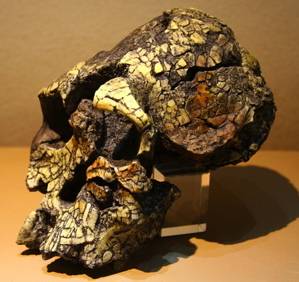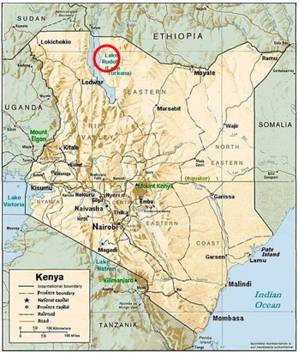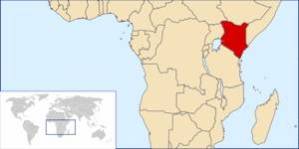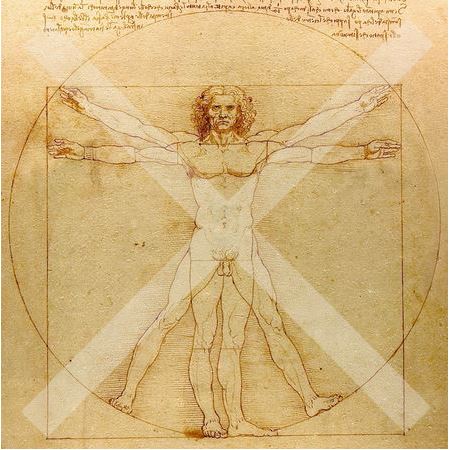|
|
EUGENE M. MCCARTHY, PHD GENETICS

|
|
Kenyanthropus platyopsbr>KNM-WT 40000 Image: Pavel Svejnar |

|
| Site of discovery |

|
| Location of Kenya
Credit: Vardion |
The single skull (specimen KNM-WT 40000) on which this hominid is based was first found at Lake Turkana in northwestern Kenya (see maps below right) in 1999 by Justus Erus, a member of an expedition led by Meave Leakey.
Dating to between 3.5 and 3.2 mya, it is highly fragmented (Leakey et al. 2001). Moreover, the individual pieces are greatly distorted because they have large cracks filled with material from the formation in which they were found (see figure right).
As a result, it's not surprising that reconstruction of the skull has been difficult. However, K. platyops seems to have had a broad flat face. The teeth show features of both humans and apes. Brain size estimates have indicated a cranial capacity of about 350 cc, about the same as that of a chimpanzee.
It is unknown whether this hominid was bipedal. The skull dates to about a million years before the earliest known use of tools and long predate the first use of fire.
Although Leakey et al. (2001) erected a new genus to accommodate this skull, there is as yet no real consensus as to whether Kenyanthropus platyops is even distinct from the contemporary and much better known Australopithecus afarensis. For example, Tim White, a member of the team who discovered Lucy in 1973, argued that K. platyops is merely a Kenyan version of Australopithecus afarensis and that the subtle differences between the two do not warrant their separate treatment. There are also those who think it's similar to Homo rudolfensis, which existed in the same geographic region, but more than a million years later.
Perhaps Kenyanthropus platyops actually is something new, but only time and further debate will tell.
Perhaps we are not from the apes alone?
Learn more >>

|
|
Habitat: Woodland. Pronunciation: kehn-YAN-thrə-pəs PLAT-ee-awps. Etymology: The Greek suffix -anthropus was added to Kenya to produce Kenyanthropus, meaning "human from Kenya," and the Greek prefix platy- was added to the Greek suffix -ops to produce platyops, meaning flat-faced. |
Interesting facts about other members of genus Homo:
Australopithecus bahrelghazali >>
Australopithecus bahrelghazali
© Macroevolution.net
Most shared on Macroevolution.net:
Human Origins: Are we hybrids?
On the Origins of New Forms of Life
Mammalian Hybrids
Cat-rabbit Hybrids: Fact or fiction?
Famous Biologists
Dog-cow Hybrids
Prothero: A Rebuttal
Branches of Biology
Dog-fox Hybrids